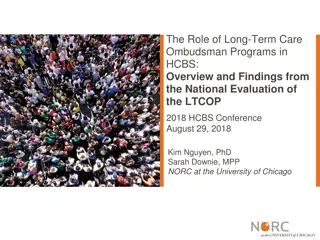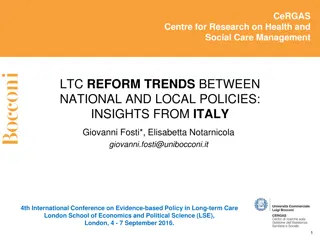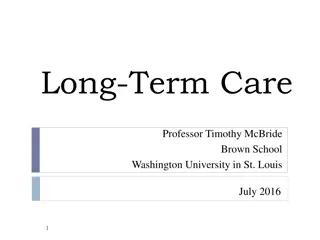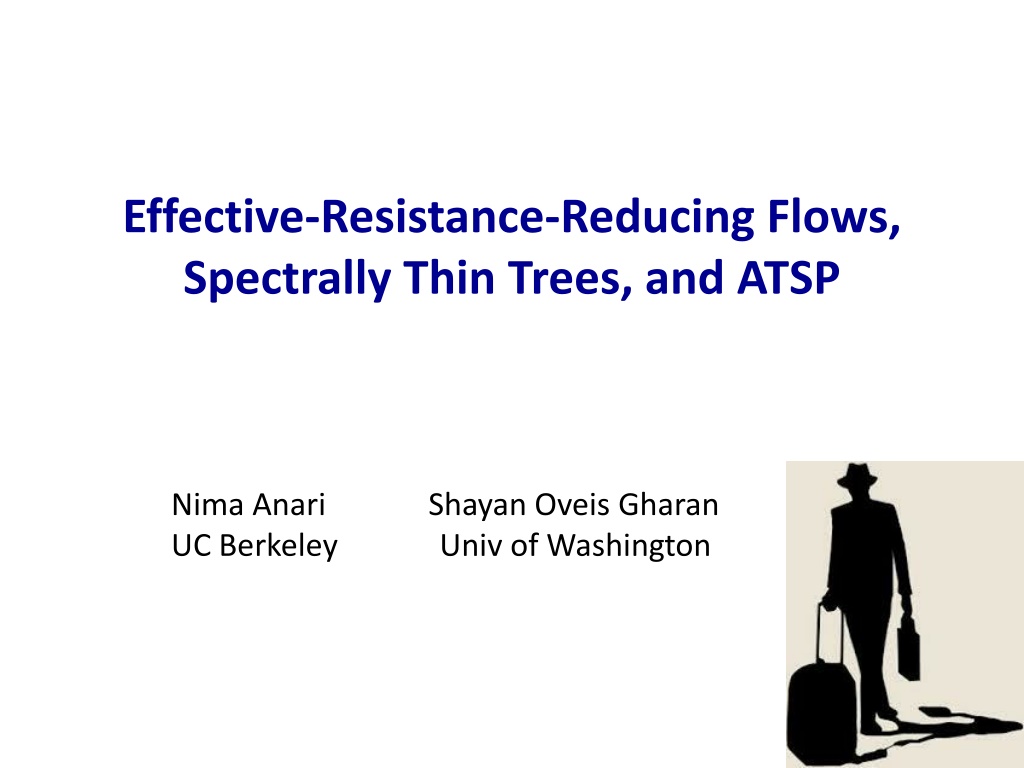
Effective Resistance Reducing Flows and ATSP in Optimization
Explore topics such as effective resistance reducing flows, ATSP, linear programming relaxation, and previous works in the field of approximation algorithms for optimization problems like the Asymmetric Traveling Salesman Problem (ATSP).
Download Presentation

Please find below an Image/Link to download the presentation.
The content on the website is provided AS IS for your information and personal use only. It may not be sold, licensed, or shared on other websites without obtaining consent from the author. Download presentation by click this link. If you encounter any issues during the download, it is possible that the publisher has removed the file from their server.
E N D
Presentation Transcript
Effective-Resistance-Reducing Flows, Spectrally Thin Trees, and ATSP Nima Anari UC Berkeley Shayan Oveis Gharan Univ of Washington
Asymmetric TSP (ATSP) Given a list of cities and their pairwise distances , satisfying the triangle inequality, ?(?,?) ?(?,?) + ?(?,?). Find the shortest tour that visits all cities exactly once. Asymmetric: ? ?,? ?(?,?). 2
Linear Programming Relaxation [Held-Karp72] ??? ?,?? ?,? ??,? ?.?. ???,?= ???,? ? ? ? ?,? ???,? 1 0 ??,? ? ? ?(OPT tour) ?(OPT LP) max ?(.,.) Integrality Gap: 3
Previous Works Approximation Algorithms log(n) [Frieze-Galbiati-Maffioli 82] .999 log(n) [Bl ser 02] 0.842 log(n) [Kaplan-Lewenstein-Shafrir-Sviridenko 05] 0.666 log(n) [Feige-Singh 07] O(logn/loglogn) [Asadpour-Goemans-Madry-O-Saberi 09] O(1) (planar/bd genus) [O-Saberi 10,Erickson-Sidiropoulos 13] Integrality Gap 2 [Charikar-Goemans-Karloff 06] O(logn/loglogn) [AGMOS 09]. 4
Main Result For any cost function, the integrality gap of the LP relaxation is polyloglog(n). 5
Plan of the Talk Thin Spanning Tree ATSP Max Effective Resistance Spectrally Thin Spanning Tree Our Contribution 6
Thin Spanning Trees Def: Given a k-edge-connected graph ? = (?,?). A spanning tree ? is ?-thin w.r.t. G if ? ?, ? ? |? ?, ? | ? ?, Ideally want ? = ? 1 ? , One-sided unweighted cut-sparsifier No lower-bound on |? ?, ? | ? But even ?<0.99 is interesting ? ? ? Kn 2/n-thin tree Exercise: Show that ??(k-dim cube) has O(1/k) thin tree 7
From Thin Trees to ATSP ?(?) log(?), [AGMOS 09]:If for any log(?)-connected graph ? then the integrality gap of LP is O(? ? ). Furthermore, finding the tree algorithmically gives O(? ? )-approximation algorithm for ATSP. Proof Idea: Max-flow/Min-cut thm. 8
Previous Works: Randomized Rounding Thm: Any k-connected graph G has a ? log(?) thin tree ? Pf. Sample each edge of G, indep, w.p. 2log ? /?. By Karger s cut counting argument, the sampled graph is O(log n k )-thin w.h.p. log(?) ?.log log(?). [AGMOS 09]: Improved the above bound to by sampling random spanning trees. 9
Main Result Any ?-edge-connected graph has an ?(polyloglog ? /?)-thin tree. For any cost function, the integrality gap of the LP Relaxation is polyloglog(n). 10
In Pursuit of Thin Trees Beyond Randomized Rounding 11
Graph Laplacian Let ??,?= 1? 1? For ? ?, let ??= (?,?) ???,???,? ?, 2 1 2 0 1 1 0 2 1 0 1 1 0 1 1 2 ??= Laplacian Quadratic Form: 2, ????? = (?,?) ??? ?? E.g., ???1?= ? ?, ? 1? 12
Spectrally Thin Spanning Trees Def: A spanning tree ? is ?-spectrally thin w.r.t. G if ?? ? ?? ?.?. ????? ? ?????, ? Why? Generalizes (combinatorial) thinness. ?-spectral thinness implies ?-combinatorial thinness ? ?,1? ???1? ?1? ???1? Testable in polynomial time. Compute max eigenvalue of 1/2???? 1/2 ?? 13
A Necessary Condition for Spectral Thinness Lem: The spectral thinness of any T is at least max ? ?Reff?(?), where ??? 1??,?, Reff??,? = ??,? ??,?= 1? 1?. Pf. If T is ?-spectrally thin, then any subgraph of T is ?- spectrally thin, so ? ?, ???? Reff??,? is the spectral thinness of ? = {?,?}. ?? ?= ?? ? ?? 1?? ?. ??? 14
A k-con Graph with no Spectrally Thin Tree For any spanning tree, T, ? ?Reff?? 1 ?2 max ?. 1A k edges Reff ? 1 ?2 ? 1A k edges n/k vertices 15
A Sufficient Condition for Spectral Thinness [Marcus-Spielman-Srivastava 13,Harvey-Olver 14]: Any G has an ?(max ? ?Reff?(?))-spectrally thin tree. So, any edge-transitive k-connected graph (e.g., ??) has an O(1/k)-(spectrally) thin tree. 16
Spectrally Thin Trees (Summary) k-edge connectivity O(1/k)-combinatorial thin tree ? Reff?? 1/? for all ? ? O(1/k)-spectrally thin tree [MSS13] 17
https://encrypted-tbn3.gstatic.com/images?q=tbn:ANd9GcT0yRf03PDE7LGP0Imo6GC-hf-U-MA8QJM4_PiAhavmO9db59tohttps://encrypted-tbn3.gstatic.com/images?q=tbn:ANd9GcT0yRf03PDE7LGP0Imo6GC-hf-U-MA8QJM4_PiAhavmO9db59to Our Approach 18
Main Idea Symmetrize L2 structure of G while preserving its L1 structure 19
An Example n/k vertices Reff?+?? 1/ ? for all black edges 20
An Observation An Application of [MSS 13]:If for any cut (?, ?), avg ? (?, ?) Reff?? ?, Then G has a ? ? -spectrally thin tree. 21
Main Idea ? ?Reff?+?(?) ?(1 Find a ``graph D s.t. max ?) and ???1? 1? ???1?. ?? ??? i.e., ?, 1? Bypasses Spectral Thinness Barrier. D+G has a spectrally thin tree and any spectrally thin tree of G+D is (comb) thin in G. 22
An Impossibility Theorem Thm: There is a k-connected graph G, s.t., for any 0 ? ???, max ? ?Reff?? = 1 . 23
Proof Overview G has ?( comb thin tree 1 ?)- k-connected graph G for ? log(?) Note we may have ? ?, ? |? ?, ? | Main D is not a graph Tech Thm 0 ? ???, ? ?, F is (?)-connected, max ? + ? has ? spectrally thin tree A General. of [MSS 13] 1 ? - ? ?Reff?? = ?( 1 ?) 24
Thin Basis Problem Thm: Given a set of vectors ?? ? ? ? s.t. ????? ? , 2 ?. max ? ? ?? ? ? ? disjoint bases, ...... , there are 1 then there is a basis ?? ? ? If s.t. d Linearly independent set of vectors ? ?????? ?(?). 25
Proof Overview G has ?( comb thin tree 1 ?)- k-connected graph G for ? log(?) Main Tech Thm 0 ? ???, ? ?, F is (?)-connected, max ? + ? has ? spectrally thin tree A General. of [MSS 13] 1 ? - ? ?Reff?? = ?( 1 ?) 26
A Weaker Goal: Satisfying Degree Cuts Thm: Given a k-connected graph, 0 ? ???, s.t., for all v, ?? ? ?Reff?? ?, for ? = ?( 1 ?). Let ? = ?:Reff?e 2? , then by Markov Ineq, ? ? ? ? 2, for all v. By [MSS13] implies existence of ?(1 ?)-thin edge covers. 27
A Convex Program for Optimum D Recall convexity of matrix inv 1 2? + ? 1 1 2? 1+1 ??? max ? ??? ? ?Reff?? 2? 1 Has exp. many constraints: 1? ?.?. ? ??? ??1? 1? ???1? If write ? ??, then optimum ? is ?? ? 0 Thm: For any k-connected graph, the optimum is ?(1/?). Proof Idea: The dual is ?(1/?). 28
Main Result Any ?-edge-connected graph has an ?(polyloglog(?)/k)-thin tree. For any cost function, the integrality gap of the LP Relaxation is polyloglog(n). 29
Conclusion Main Idea: Symmetrize L2 structure of G while preserving its L1 structure Tools: Interlacing polynomials/Real Stable polynomials Convex optimization Graph partitioning High dimensional geometry 30
Future Works/Open Problems Algorithmic proof of [MSS 13] and our extension. Existence of C/k thin trees and constant factor approximation algorithms for ATSP. Subsequent work: Svensson designed a 27-app algorithm for ATSP when c(.,.) is a graph metric. 31

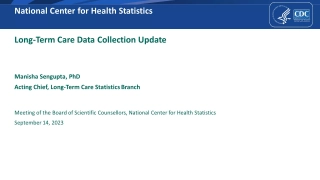

![Long-Range Wireless Charging Market Report & Analysis _ BIS Research [2024-2035]](/thumb/87166/long-range-wireless-charging-market-report-analysis-bis-research-2024-2035.jpg)





